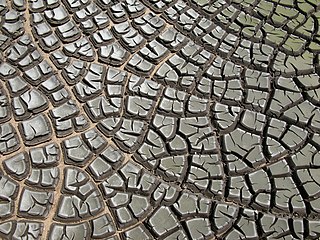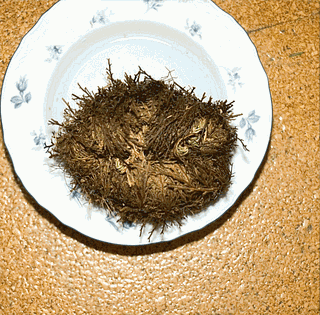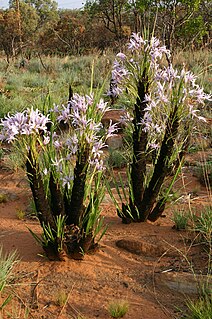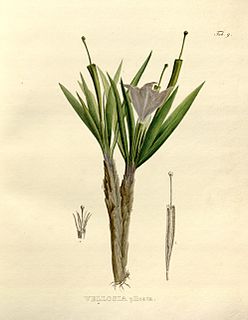
Lantana ( ) is a genus of about 150 species of perennial flowering plants in the verbena family, Verbenaceae. They are native to tropical regions of the Americas and Africa but exist as an introduced species in numerous areas, especially in the Australian-Pacific region, South and Northeastern part of India. The genus includes both herbaceous plants and shrubs growing to 0.5–2 m (1.6–6.6 ft) tall. Their common names are shrub verbenas or lantanas. The generic name originated in Late Latin, where it refers to the unrelated Viburnum lantana.

Desiccation is the state of extreme dryness, or the process of extreme drying. A desiccant is a hygroscopic substance that induces or sustains such a state in its local vicinity in a moderately sealed container.
Cryptobiosis or anabiosis is a metabolic state of life entered by an organism in response to adverse environmental conditions such as desiccation, freezing, and oxygen deficiency. In the cryptobiotic state, all measurable metabolic processes stop, preventing reproduction, development, and repair. When environmental conditions return to being hospitable, the organism will return to its metabolic state of life as it was prior to the cryptobiosis.

Yushania is a genus of bamboo in the grass family.

A resurrection plant is any poikilohydric plant that can survive extreme dehydration, even over months or years.

Velloziaceae is a family of monocotyledonous flowering plants. The APG II system, of 2003, also recognizes this family, and assigns it to the order Pandanales.

Established in 1897, Franklin Baker Company is a manufacturer and exporter of desiccated and processed coconut products in the U.S. and abroad. The company manufactures the retail coconut brand Baker's Coconut.
Begonia xerophyta is a species of plant in the family Begoniaceae. It is endemic to Ecuador. Its natural habitat is subtropical or tropical moist montane forests. It is threatened by habitat loss.
Saurauia scabrida is a species of plant in the Actinidiaceae family. It is endemic to Mexico.
Desiccation tolerance refers to the ability of an organism to withstand or endure extreme dryness, or drought-like conditions. Plants and animals living in arid or periodically arid environments such as temporary streams or ponds may face the challenge of desiccation, therefore physiological or behavioral adaptations to withstand these periods are necessary to ensure survival. In particular, insects occupy a wide range of ecologically diverse niches and, so, exhibit a variety of strategies to avoid desiccation.

Deinococcus radiodurans is an extremophilic bacterium and one of the most radiation-resistant organisms known. It can survive cold, dehydration, vacuum, and acid, and therefore is known as a polyextremophile. It has been listed as the world's toughest known bacterium in The Guinness Book Of World Records.
Ectrosia is a genus of Asian, Australian, and Pacific Island plants in the grass family.

Amentoflavone is a biflavonoid constituent of a number of plants including Ginkgo biloba, Chamaecyparis obtusa (hinoki), Hypericum perforatum and Xerophyta plicata.

Xerophyta is a plant genus in the family Velloziaceae erected in 1789. It is native to Africa, Madagascar, and the Arabian Peninsula.

Xerophyta retinervis is a deciduous perennial up to 2 metres tall with stout, erect stems, densely covered in persistent, fibrous leaf bases, often charred and blackened by veldfires. Fragrant flowers appear after fire or rain, and are blue or mauve, or rarely white. The small capsules are covered in rough hairs and are loculicidally dehiscent, releasing numerous small, black angled seeds about 2 mm long. The species is tolerant of extreme conditions such as drought, fire, and low temperatures. The old leaf bases are arranged so that rainwater is funnelled down and to the core, where it is absorbed by densely packed roots that run the entire length of the stem. Strap-shaped leaves occur in tufts along stems.

Pre-harvest crop desiccation refers to the application of an agent to a crop just before harvest to kill the leaves and/or plants so that the crop dries out from environmental conditions ("dry-down") more quickly and evenly. In agriculture, the term desiccant is applied to an agent that promotes dry down, thus the agents used are not chemical desiccants, rather they are herbicides and/or defoliants used to artificially accelerate the drying of plant tissues. Desiccation of crops through the use of herbicides is practiced worldwide on a variety of food and non-food crops.

Nanuza plicata is a plant species in the family Velloziaceae, endemic to Brazil.
Grevillea scabrida is a shrub of the genus Grevillea native to an area in the north eastern Wheatbelt region of Western Australia.
Corymbia scabrida, commonly known as the rough-leaved yellowjacket, is a species of small tree that is endemic to central Queensland. It has rough, tessellated bark on the trunk and branches, a crown of juvenile and intermediate leaves, flower buds in groups of seven, white flowers and barrel-shaped to urn-shaped or shortened spherical fruit.

Xerophyta elegans is a species of plants in the family Velloziaceae. It is endemic to South Africa and its natural distribution and habitat is restricted to Drakensberg Mountains in Mpumalanga province. The plant is evergreen and similar to other members of its family it is able to express high level or tolerance against desiccation and even long treatment with sulphuric acid under dry conditions leaves it able to revive and restart its photosynthetic abilities. Talbotia produces narrow but long, leathery leaves and white star-shaped flowers with yellow stamens. The seeds are hooked thus enhancing dispersal by animals.










